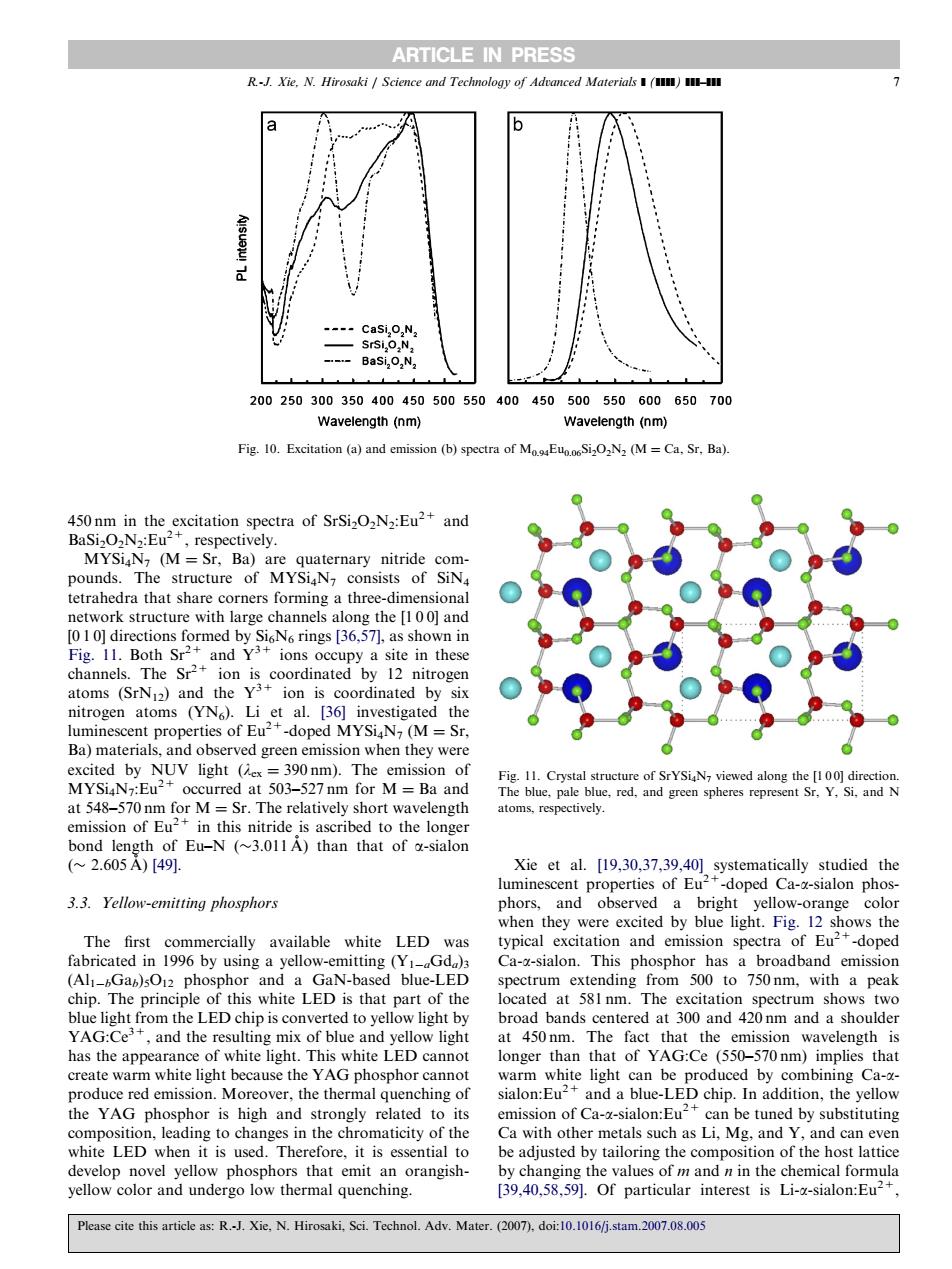正在加载图片...

ARTICLE IN PRESS 200250300350400450500550400450500550600650700 Wavelength (nm) Fig10.Excitation (a)and cm ion (b)spectra of(M=Ca.Sr.Ba). pectra of:Eu2+and MYSiN(M=Sr,Ba)are quaternary nitride com pounds.The structure of MYSiN consists of SiN forming a t Fig.11.Both S ions occupy a site in these channels 12 nitrogen atoms (YN).Li et al.[36]investigated the luminescent properties of Eu2+-doped MYSiN (M=Sr. Ba)mate d green emission when they were 15007m for M=B at 548-570m for M=Sr.The relatively short wavelength rp e.red.and green spheres represent Sr.Y,Si.and emission of Eu mmatically studied the 3.3.Yellow-emitting phosphors phors,and observed a bright yellow-orange colo hen were excited by blue light.Fig.1 th C--sialon This pho snhor has roadband em (Al-Ga)sO1 phosphor and a GaN-based blue-LED spectrum extending from 500 to 750nm,with a peak Er this ocated at 581 nm. YAG-Cen the 450D at the has the appearance of white light.This white LED cannot longer than that of YAG:Ce (550-570nm)implies that over,the thermal on, e y composition.leadins to chanees in the chromaticity of the Ca with other metals such as Li Me and Y.and can ever white LED when it is used.Therefore,it is essential to be adjusted by tailoring the composition of the host lattice Please cite this article as:R.Xie.N.Hirosaki,Sci.Technol.Adv.Mater.(2007).doi:10.1016/j-stam 2007.08.05450 nm in the excitation spectra of SrSi2O2N2:Eu2+ and BaSi2O2N2:Eu2+, respectively. MYSi4N7 (M ¼ Sr, Ba) are quaternary nitride compounds. The structure of MYSi4N7 consists of SiN4 tetrahedra that share corners forming a three-dimensional network structure with large channels along the [1 0 0] and [0 1 0] directions formed by Si6N6 rings [36,57], as shown in Fig. 11. Both Sr2+ and Y3+ ions occupy a site in these channels. The Sr2+ ion is coordinated by 12 nitrogen atoms (SrN12) and the Y3+ ion is coordinated by six nitrogen atoms (YN6). Li et al. [36] investigated the luminescent properties of Eu2+-doped MYSi4N7 (M ¼ Sr, Ba) materials, and observed green emission when they were excited by NUV light (lex ¼ 390 nm). The emission of MYSi4N7:Eu2+ occurred at 503–527 nm for M ¼ Ba and at 548–570 nm for M ¼ Sr. The relatively short wavelength emission of Eu2+ in this nitride is ascribed to the longer bond length of Eu–N (3.011 A˚ ) than that of a-sialon ( 2.605 A˚ ) [49]. 3.3. Yellow-emitting phosphors The first commercially available white LED was fabricated in 1996 by using a yellow-emitting (Y1aGda)3 (Al1bGab)5O12 phosphor and a GaN-based blue-LED chip. The principle of this white LED is that part of the blue light from the LED chip is converted to yellow light by YAG:Ce3+, and the resulting mix of blue and yellow light has the appearance of white light. This white LED cannot create warm white light because the YAG phosphor cannot produce red emission. Moreover, the thermal quenching of the YAG phosphor is high and strongly related to its composition, leading to changes in the chromaticity of the white LED when it is used. Therefore, it is essential to develop novel yellow phosphors that emit an orangishyellow color and undergo low thermal quenching. Xie et al. [19,30,37,39,40] systematically studied the luminescent properties of Eu2+-doped Ca-a-sialon phosphors, and observed a bright yellow-orange color when they were excited by blue light. Fig. 12 shows the typical excitation and emission spectra of Eu2+-doped Ca-a-sialon. This phosphor has a broadband emission spectrum extending from 500 to 750 nm, with a peak located at 581 nm. The excitation spectrum shows two broad bands centered at 300 and 420 nm and a shoulder at 450 nm. The fact that the emission wavelength is longer than that of YAG:Ce (550–570 nm) implies that warm white light can be produced by combining Ca-asialon:Eu2+ and a blue-LED chip. In addition, the yellow emission of Ca-a-sialon:Eu2+ can be tuned by substituting Ca with other metals such as Li, Mg, and Y, and can even be adjusted by tailoring the composition of the host lattice by changing the values of m and n in the chemical formula [39,40,58,59]. Of particular interest is Li-a-sialon:Eu2+, ARTICLE IN PRESS Fig. 10. Excitation (a) and emission (b) spectra of M0.94Eu0.06Si2O2N2 (M ¼ Ca, Sr, Ba). Fig. 11. Crystal structure of SrYSi4N7 viewed along the [1 0 0] direction. The blue, pale blue, red, and green spheres represent Sr, Y, Si, and N atoms, respectively. R.-J. Xie, N. Hirosaki / Science and Technology of Advanced Materials ] (]]]]) ]]]–]]] 7 Please cite this article as: R.-J. Xie, N. Hirosaki, Sci. Technol. Adv. Mater. (2007), doi:10.1016/j.stam.2007.08.005����